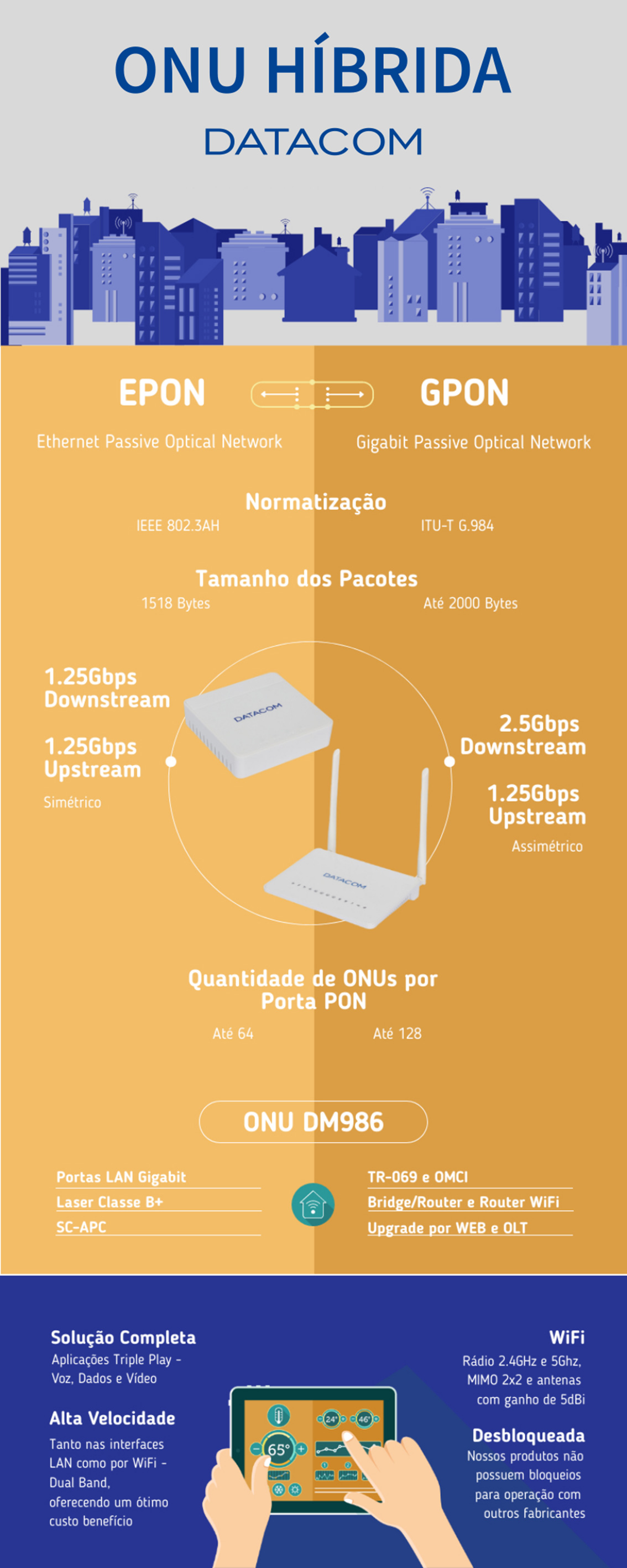Knowledge in one place.
By Rodrigo Vian – Support Engineer and Douglas Cruz – Sales Engineer
We know that the growth in internet demand has been intensifying in recent years. Many providers that operated using internet via radio saw the need to migrate to the operation with fiber optics in their network, and thus be able to provide their customers with higher quality of service and plans with higher speeds.
Migrating the operation to the fiber optic network, the provider may wonder what technology to invest in. Questions such as: “Which equipment should make up my optical network? Should I choose an EPON network or do I start with GPON”?
In this article, we'll show you how the acquisition of ONUs (Optical Network Units) can play a key role in answering the above questions, as well as in planning the evolution of your infrastructure.
EPON or GPON?
The idea of this article is not to present a detailed comparison between the two technologies, but it is worth understanding the main differences and what advantages the provider will have when choosing one of them.
Both EPON and GPON make use of the FTTX architecture, Fiber to the "X", where the "X" varies according to the location where the UN is delivered, and can be directly at the customer's home, FTTH (Fiber To The Home ), in a condominium, FTTB (Fiber To The Build), or even replacing the structured cabling of a company, the so-called FTTD (Fiber To The Desk).
Both solutions ensure a quality infrastructure with regard to speed and quality of data delivery. Basically, we can mention two main points that can influence the choice of one of them:
And the UNs, how do they affect this decision?
The investment in equipment installed at the end customer's home represents a large part of the cost of an FTTx network. That is, the provider will need to consider one UN for each customer serviced and this volume often leads to device choice based solely on price. This is precisely where the topic of the article comes in, as it is important to consider other points for the proper choice.
If the provider is not sure how its network will grow, the tendency to start opting for equipment with low port density is great. This means that the provider can start the network with EPON planning to migrate to GPON in the medium/long term. Thinking this way, choosing hybrid ONUs can be a great option.
Hybrid ONUs are equipment that have the characteristic of operating with the two technologies mentioned above, that is, GPON and EPON, without the need to replace the hardware. Its main advantage is to provide the provider with the possibility of having, in a single device, two types of connection, preventing the investment in hardware from becoming obsolete in an eventual evolution of the network to GPON.
In addition to not needing to acquire new ONUs, this practice automatically brings a considerable operational reduction, as the technician would not need to visit for exchange. Basically, the provider would invest in the replacement of the concentrator equipment, that is, the OLT.
Given this scenario, even with the portfolio of OLTs aimed at newer technologies (GPON and in the future XGS-PON), DATACOM makes available in its portfolio the Hybrid ONUS of the DM986 family: ONU DM986-100 is a compact ONU that operates both in Bridge mode and Router mode. The ONU DM986-414 is a complete ONU, operating in Router mode, delivering high-speed traffic both in its LAN ports and in Wi-Fi 802.11ac.
Check below for details of these ONUs models in the infographic with the main characteristics.
